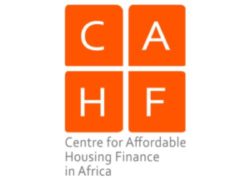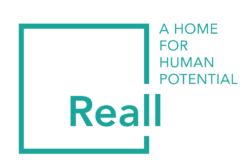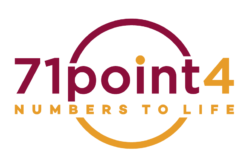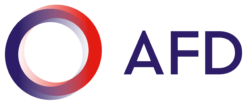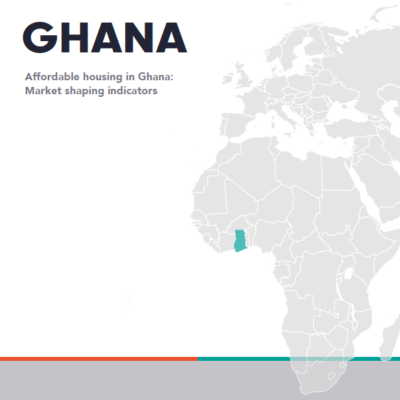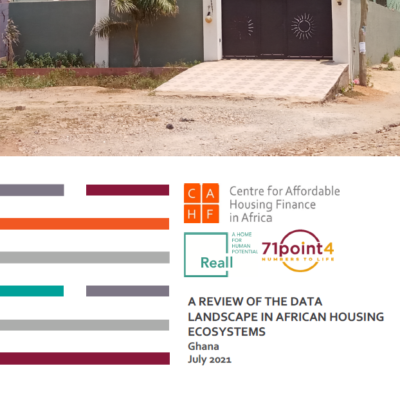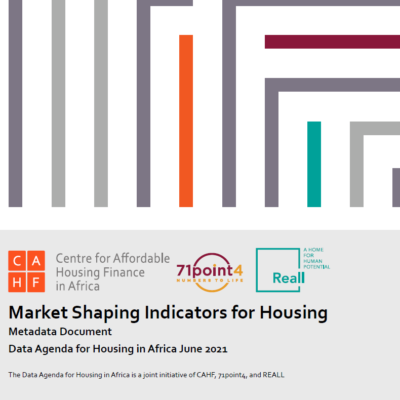Ghana - Market Shaping Indicators
View Reall projects in GhanaReall has been active in Ghana since 2014, and is currently invested in Tamale, capital of the northern part of the region. Reall partnered with a private developer, Afreh Group, to deliver 100 homes for co-operative members of the Tamale Community Cooperative Union, and these homes were completed in December 2020. CAHF has undertaken various work with the support of local partners to support and contribute to the development of Ghana’s housing and housing finance sectors. Together with the Ghana yearbook profile, CAHF’s research is an important input into the broader Data Agenda work in Ghana—identifying key gaps in housing market data that would help create a better understanding of the housing ecosystem, for more targeted interventions and policy.
Country Overview
In December 2020, Ghana concluded tightly contested elections with the looming challenge of tackling high levels of unemployment and boosting the economy which has been badly hit by the coronavirus pandemic. The mortgage system in the country is at an elementary stage of development but appears promising as the government has pledged commitment to make housing financing available.
The government has set up the National Housing and Mortgage Fund (NHMF) in partnership with Ghana Commercial Bank, Republic Bank and Stanbic Bank to deepen access to mortgage and residential housing finance. The 2015 National Housing Policy continues to provide direction for housing development in the country, with emphasis on the private sector involvement in affordable housing finance and delivery. Similarly, through the NHMF partnering with GCB Securities, an Affordable Housing Real Estate Investment Trust (REIT) was set up to provide rental homes for public sector workers. Looking forward, Ghana’s enabling environment and growing population makes it a fertile place for potential investors to contribute meaningfully to addressing a national issue by investing in the housing sector.
State of Housing Data
Data on housing is sparse and those available are often dated. The Ghana Statistical Service (GSS) collects and publishes data on housing after conducting the population and housing census, which is undertaken every decade. Due to the pandemic the census, which was to be conducted in 2020, has been postponed to 2021. The data covered by GSS includes housing and land access, demand and supply, housing finance and infrastructure, and access to basic service. The Bank of Ghana’s data on housing finance is very limited and only focuses on mortgage rates. This information is publicly available online. The main data gaps related to housing finance include yearly housing stock increase, number of mortgages outstanding, mortgage loan performance, average property values, loan to value ratios, and disaggregated data on mortgages by region among others.
Closing data gaps requires more detailed scoping and engagement with Ghana Statistical Services, Bank of Ghana, Ministry of Works and Housing and the Lands Commission, to get a better understanding of the Ghanaian data landscape. For example, the aggregation of its macroeconomic and financial sector data limits the understanding and analysis of the economic impact of the housing sector. In some cases, gaps can be resolved by simply requiring the dissemination of data that is already collected by these institutions.
Text on this page is based on the MSI Ghana Country Profile ¹, drawn from Centre for Affordable Housing Finance (2020). Housing Finance in Africa Yearbook: 11th Edition 2020 ², with additional content from CAHF and Reall.
Key Indicators
1. Land & Infrastructure
% of urban bottom 40 households without access to basic sanitation services
| Country | Year | Data Source | Value |
|---|---|---|---|
| Cote d'Ivoire | 2012 | DHS | 96.5% |
| Ghana | 2014 | DHS | 93.15% |
| Kenya | 2014 | DHS | 88.25% |
| Morocco | 2004 | DHS | 52.05% |
| Mozambique | 2011 | DHS | 95.6% |
| Nigeria | 2018 | DHS | 83.1% |
| Tanzania | 2017 | DHS | 37% |
| Uganda | 2016 | DHS | 94.5% |
| Rwanda | 2016 | National Institute of Statistics Rwanda (NISR) | 13.13% |
| Pakistan | 2018 | The DHS Program | 2.75% |
| India | 2018 | NSSO 76th Round | 0.2% |
2. Construction & Investment
% of urban population living in slums, informal settlements, or inadequate dwellings
| Country | Year | Data Source | Value |
|---|---|---|---|
| Cote d'Ivoire | N/A | ||
| Ghana | N/A | ||
| Kenya | N/A | ||
| Morocco | N/A | ||
| Mozambique | N/A | ||
| Nigeria | N/A | ||
| Tanzania | N/A | ||
| Uganda | N/A | ||
| Rwanda | 2018 | World Bank | 42.1% |
| Pakistan | N/A | ||
| India | 2018 | NSSO 76th Round | 35% |
3. Sales & Rental
Price of the cheapest, newly built dwelling by a formal developer or contractor
| Country | Year | Data Source | Value |
|---|---|---|---|
| Cote d'Ivoire | 2018 | Site d'annonce et promotion dans l'immobilier en Côte d'Ivoire | 15,500,000 CFA$27,087.48 |
| Ghana | 2019 | Damax Construction Co. Ltd | 108,704 GH₵$19,621.66 |
| Kenya | 2019 | Tsavo Real Estate | 4,000,000 Ksh$37,037.04 |
| Morocco | 2019 | Various real estate websites | 250,000 DH$27,027.03 |
| Mozambique | 2016 | Casa Minha | 3,418,491 MZ$48,147.76 |
| Nigeria | 2019 | Millard Fuller Foundation; Shelter Origins | 2,900,000 NGN$7,651.72 |
| Tanzania | 2018 | CAHF | 37,966,107 TZS$16,508.58 |
| Uganda | 2019 | Various property developers | 125,000,000 UGX$34,097.11 |
| Rwanda | 2020 | Marchal Real Estate Developers | 10,000,000 R₣$11,119.14 |
| Pakistan | 2021 | Partners | 2,500,000 PKR$14,305.33 |
| India | 2022 | Real estate websites and industry experts | 160,000 IN₹$2,176.87 |
3. Sales & Rental
% of national households that rent their dwelling
| Country | Year | Data Source | Value |
|---|---|---|---|
| Ghana | 2017 | Ghana Statistical Service | 28% |
| Kenya | 2019 | Central Bank of Kenya, Kenya National Bureau of Statistics, FSD Kenya | 35.01% |
| Morocco | 2014 | High Commission for Planning; World Bank | 18.5% |
| Nigeria | 2018 | World Bank; Nigeria National Bureau of Statistics | 21.8% |
| Tanzania | 2017 | National Bureau of Statistics | 80.56% |
| Uganda | 2016 | DHS | 53.45% |
| Rwanda | 2020 | Access to Finance Rwanda (AFR) and National Institute of Statistics Rwanda (NISR) | 8.94% |
| Pakistan | 2017 | Population and Housing Census | 11.53% |
| India | 2018 | NSSO 76th Round | 13% |
5. Enabling Environment
Ease of Doing Business Index Rank: Global
| Country | Year | Data Source | Value |
|---|---|---|---|
| Cote d'Ivoire | 2020 | World Bank | 110 |
| Ghana | 2020 | World Bank | 118 |
| Kenya | 2019 | World Bank Ease of Doing Business | 61 |
| Morocco | 2020 | World Bank | 53 |
| Mozambique | 2019 | World Bank | 74 |
| Nigeria | 2020 | World Bank | 131 |
| Tanzania | 2020 | World Bank | 141 |
| Uganda | 2020 | World Bank | 116 |
| Rwanda | 2020 | World Bank Ease of Doing Business Indicators | 38 out of 190 |
| Pakistan | 2020 | World Bank Doing Business Indicator | 108 out of 190 |
| India | 2020 | World Bank | 63 out of 190 |
6. Economic Environment
GDP Per Capita
| Country | Year | Data Source | Value |
|---|---|---|---|
| Cote d'Ivoire | 2018 | World Bank | 1,024,171 CFA$1,789.82 |
| Ghana | 2019 | World Bank | 11,489 GH₵$2,073.83 |
| Kenya | 2018 | World Bank | 173,272 Ksh$1,604.37 |
| Morocco | 2018 | World Bank | 30,725 DH$3,321.62 |
| Mozambique | 2018 | World Bank | 30,772 MZ$433.41 |
| Nigeria | 2018 | World Bank | 659,159 NGN$1,739.21 |
| Tanzania | 2018 | National Bureau of Statistics; World Bank | 2,297,020 TZS$998.80 |
| Uganda | 2018 | World Bank | 2,357,327 UGX$643.02 |
| Rwanda | 2019 | World Bank | 737,578.59 R₣$820.12 |
| Pakistan | 2020 | World Bank National Accounts Data | 188,900 PKR$1,080.91 |
| India | 2020 | Ministry of Statistics and Program Implementation | 151,760 IN₹$2,064.76 |
7. Demand
Population Size
| Country | Year | Data Source | Value |
|---|---|---|---|
| Cote d'Ivoire | 2017 | World Bank | 24,437,469 |
| Ghana | 2019 | World Bank | 30,417,856 |
| Kenya | 2017 | World Bank | 50,221,473 |
| Morocco | 2017 | World Bank | 36,471,769 |
| Mozambique | 2018 | World Bank | 29,495,962 |
| Nigeria | 2017 | World Bank | 190,873,311 |
| Tanzania | 2019 | World Bank | 58,005,463 |
| Uganda | 2017 | World Bank | 41,487,000 |
| Rwanda | 2019 | World Bank | 12,626,950 |
| Pakistan | 2020 | World Bank National Accounts Data | 220,892,331 |
| India | 2021 | Minsitry of Health and Family Welfare | 1,361,343,000 |
All Indicators
Please enter 3 or more characters to begin search.
You can then click on a result to be taken to the relevant tab.
The Market Shaping Indicators project is a work in progress. Significant gaps exist in data, which will be filled in future revisions. We would recommend checking back regularly for updates. We are keen to receive any feedback that you have on this Dashboard, which can be sent to [email protected].
Using the Dashboard
The indicators are split into 6 key areas, split into the Housing Value Chain: Land & Infrastructure, Construction & Investment, Sales & Rental, Maintenance & Management, Enabling Environment, Economic Environment and Demand, shown in the following tabs. Navigation can either be undertaken by using the tabs, or through the Search box immediately above. Above this, currency indicators can be toggled between USD and local currency.
Users are able to further interrogate each indicator each indicator through clicking on the arrows to the left of each indicator. This expanded section shows the data elements that are used to produce the overall indicator value, dates of data collection, source details, hyperlinks to the original data where possible, and a breakdown of data quality. The majority of indicators are quality assessed, based on the whether they are: Interpretable; Relevant; Sufficiently Accurate; Representative; Timely; and Accessible. Indicators are scored on each of these criteria using a 1-4 star system, detailed below:
☆ – poor
☆☆ – moderate
☆☆☆ – good
☆☆☆☆ – excellent
Finally, all data can be downloaded for further interrogation. By clicking on Switch to Data View at the top of the screen, users can filter data based on countries and columns, and download in a .csv or .xls file.
Bottom 40
Reall targets the Bottom 40% of the urban income pyramid, referred to as the ‘Bottom 40’ or ‘B40’. An objective of the MSI work was to better understand and demonstrate the market from the perspective of households in the Bottom 40, and as such data is aggregated for this group where possible. Data for this group can be particularly challenging to come across. In part, this is due to the difficulties in accurately defining this group using existing data sets. Additionally though, the informality of much of life for lower income groups severely limits data availability, particularly in terms of key data on jobs, housing and relationships with local government. This lack of data is a key blockage for further engagement at the lower end of the housing market, and resolving this is an objective of Reall’s and of the MSI work.
Aggregations
Data is shown at various different “aggregations”, which demonstrate the size and location of the population for which the data represents. This varies from national to city level in terms of population groupings. Additional aggregations exist for the Bottom 40, as detailed above, enabling a focused view on the lower end of the market.
For relevant data, Reall’s partners are also included as an aggregation. This is not meant to be representative of the entire market, but recognises that as practitioners and experts within the lower end of the housing market of each country, their experiences are a useful check on other data sets, and an indication of the value when other data is not available.
Terms of Use
Reall Ltd (“Reallâ€) endeavours to make its data as freely available as possible in order to demonstrate the successes of its model and encourage other actors into the affordable homes movement. Reall provides the user with access to these data free of charge subject to the terms of this agreement.
Users are encouraged to use the data to benefit themselves and others in creative ways.
Unless specifically labelled otherwise, you are free to copy, distribute, adapt, display or include the data in other products for commercial or non-commercial purposes for no cost under a Creative Commons Attribution 4.0 International License, with the additional terms below.  The basic terms may be accessed here. By using or downloading the data, users are agreeing to comply with the terms of a CC BY 4.0 licence, and also agreeing to the following mandatory and binding additions:
– You agree to provide attribution to Reall in any published use of the data, including but not limited to articles, papers, blogs, books. Usage includes both direct publication of the existing data, along with any analysis undertaken by the user. This attribution should include Reall’s name and the following link – reall.net/dashboard. An electronic copy of all reports and publications based on the data should be shared with Reall ([email protected]).
– When sharing or facilitating access to the data, you agree to include the same acknowledgement requirement in any sub-licences of the data that you grant, and a requirement that any sub-licences do the same. You may meet this requirement by providing the uniform resource locator (URL) to these terms of use.
– Some datasets and indicators may be provided by third parties, and may not be redistributed or reused without the consent of the original data provider, or may be subject to additional terms and conditions. Where applicable, third party data is labelled as such, and usage conditions can be found on their respective websites.
Land
Land ownership is generally recognised under the two categories of customary and public lands. Customary lands are owned by stools, skins, families, or clans with the respective group leaders holding the lands in trust for the benefit of the members. Public lands are acquired and vested in the President of Ghana for the common good of the country. However, private ownership of lands can be acquired through grants, sale, gift or marriage ¹.
Land tenure insecurity is prominent in both the urban and rural areas of Ghana, evident in the forms of land encroachment, multiple land sales, unapproved development schemes, undetermined boundaries of customary lands, conflicting land uses between mining and agriculture sectors, and weak systems to manage such conflicts. As a result, the Ghanaian land market is dysfunctional with low levels of investment in land, owing to high transaction costs and sustained rural and urban poverty ². Efforts to enhance transparency and efficiency of land administration led to plans to digitise the land registry in 2018. It is estimated that 71 167 residential properties are registered with a title deed. The Land Registration Division of the Lands Commission is responsible for registration of title, deed and other interests or instruments affecting land.
Infrastructure
Rural to urban migration in search of employment opportunities has contributed to many Ghanaians living in substandard housing that lacks access to basic infrastructure, such as water, electricity and waste management. Transport as a percentage of household expenditure (10 percent) was the second highest key driver of inflation behind housing, water, electricity, and gas (20.3 percent) in July 2020. Access to basic infrastructure and services varies greatly within and across urban and rural areas, and requires the disaggregation and analysis of relevant data to support interventions.
Lack of access to basic sanitation services is a major challenge at the national level (82 percent lacking access) and for the urban bottom 40 of the income pyramid (93 percent). With ongoing rapid urbanisation, this poses a health risk particularly for the low-income populations. More than half (56 percent) of the urban bottom 40 households are without access to basic electricity compared to the overall population figure of 18 percent.
To reduce the hardships brought about by the pandemic, the government absorbed utility bills on water for households and businesses. Water was mobilised for vulnerable communities who did not have constant supply. In addition, electricity bills for lifeline consumers of electricity who consume less than 50 kilowatt hours a month, were fully absorbed while all others had half of their electricity bill absorbed.
Of the 23 indicators in this group, 6 are currently populated.
Compound houses (57.3 percent) account for the highest typology of house occupied, followed by separate houses (28 percent), semidetached houses (4.7 percent), huts (4.8 percent) and flat/apartments (3.3 percent). Flats and apartments have not seen popular demand due to their relatively high cost and an entrenched socio-cultural preference for individualised spaces. However, recently there has been an emerging demand spurred by the expatriate community, and non-resident Ghanaians. They view these types of accommodation as more secure than the traditional approach of incremental construction on lands which are frequently subjected to multiple sales, ownership disputes and outright stealing.
The average number of persons per house has seen a decrease since 1984, reflecting the increase in housing ownership due to improved economic conditions. In 2010, the average number of persons per house was 7.3. Based on the estimated 2020 housing stock, the average number of people per house is expected to have dropped further to 5.9. The number of people per sleeping room for urban formal and informal dwellings is 2.5 and 2.23 respectively. The figure is slightly higher for the Urban Bottom 40 of the population, with close to 3 people per sleeping room.
Of the 19 indicators in this group, 6 are currently populated.
Property Markets
The largest proportion of households in Ghana (42.1 percent) own their dwelling while 29.7 percent are living rent-free. Rent paying occupants account for 27.6 percent while perching and squatting account for a combined 0.5 percent ¹. Many Ghanaians prefer to build and own their houses incrementally, which accounts for the widespread horizontal development that has led to urban sprawl.
The housing market, segmented into the formal and informal, has a high share of informal activity made up of actors who acquire their own land and engage the services of tradesmen to build incrementally, based on resource availability. This allows for affordable construction but may affect the quality. Formal developers have often focused on the middle to high income segment of the housing market, with only a few catering to the low income segment.
The real estate sector witnessed appreciable gains as its contribution increased from 1.0 percent of GDP in 2013 to 2.7 percent in 2019 ². This represents an annual growth rate of 0.25 percent from 2013 to 2019. Despite the presence of formal real estate developers catering to the lower income segment, the prices of houses are often beyond the means of low-income earners as the buildings are priced in foreign currency. There is currently no formal recognition for the practice of estate agency in Ghana.
The annual housing growth rate of the decade up to and including 2010 was 4.4 percent ³. This resulted in a total housing stock of 3 392 745 in 2010 and an estimated figure of 5 218 626 in 2020, assuming a compounded annual rate.
Mortgages
Ghana’s financial sector broadly comprises the banking and the non-banking systems with insurance and capital markets as the components of the non-banking system. Currently, 23 banks operate as universal banks, a significant reduction from the 34 banks that operated before the implementation of the new minimum capital requirement ⁴. FNB Bank, Republic Bank, Cal Bank, Stanbic Bank, Fidelity Bank, Société Générale Ghana and Omni Bank offer a range of mortgage products including home construction, home purchase, home improvement, refinancing, and land purchase. Ghana has low levels of financial inclusion of individuals with only 10.2 percent of the adult population having borrowed formally in 2017.
Mortgage to GDP ratio has remained below 0.5 percent over the years, with 0.8 percent of households financing their housing acquisition through mortgages ⁵. On average, mortgages in Ghana are granted for a term of 15 years with a maximum loan-to-value ratio of 85 percent. In 2017, total mortgages in Ghana amounted to GH ¢114 million (US$19 789 042) which grew to GH ¢216 million (US$37 495 028) in 2018, a 90 percent increment. The rate of non-performing loans in 2019 was 13.9 percent, depicting a significant improvement in performance from 18.2 percent 2018 ⁶.
Affordability
The price offered by Damax Construction for its lowest price house is GH ¢ 115,400 (US$20,000). This is against a national average annual income of GH ¢ 33,937 (US$5,891). In Accra, it has been observed that land price appreciation of building lands ranged from 8 to 11.5 percent between 2018 and 2019 ⁷.
Often, the high interest charged on mortgages by the various mortgage and financial institutions deters workers from applying, and they prefer to use the equity of personal loans and other income sources.
Of the 40 indicators in this group, 14 are currently populated.
Majority of households in Ghana build incrementally using mostly inexpensive construction materials and the services of small-scale artisans. There is a growing argument to transform the existing housing stock and revitalise infrastructure to meet the increasing housing demand. About 78 percent of the population have no access to basic waste collection services. Land tenure insecurity in urban and rural areas of Ghana affects the ability of municipal authorities to generate revenue through the collection of property taxes.
There are 180 microfinance institutions operating under the non-banking system, offering services classified as formal, semi-formal and informal, the last of which is available to all classes of households ¹. A general concern noted by several studies points to the affordability of HMF loans in Ghana, which are strongly affected by limited access to long-term capital. This may be partly illustrated by dwelling improvements accounting for only 3.2 percent of household expenditure. As of 2018, MFIs providing housing loans charged interest rates far above local currency-denominated mortgages, as much as 15 percent higher for two to three-year durations.
Of the 6 indicators in this group, all are populated.
In efforts to bridge the housing gap, the government is supporting the construction of affordable homes and enhancing access to housing credit through mortgages for government workers. Projects initiated since 2007 and abandoned for some time, have been resuscitated and completed, or at various stages of completion ¹. The Government has also embarked on several private public partnerships (PPP). For example, in 2019 the government signed a PPP agreement with a Hungarian private company, Solin, to construct 10 000 affordable housing units across the country ².
The government has set up the National Housing and Mortgage Fund (NHMF) in partnership with Ghana Commercial Bank, Republic Bank and Stanbic Bank to deepen access to mortgage and residential housing finance. Through the NHMF, 250 housing units are being constructed as phase one, expected to be complete by September 2020 with an additional 200 housing units in phase two to be completed at Tema Community 22 ³. Similarly, through the NHMF partnering with GCB Securities, an Affordable Housing Real Estate Investment Trust (REIT) was set up to provide rental homes for public sector workers. The scheme is based on a rent-to-own model where public sector workers can access decent and affordable homes for between 15 to 20 years and pay a residual value to own the property ⁴. Lower interest rates (11.9 to 12.5 percent) are being offered as part of the scheme, compared with the nominal minimum rate of 24 percent for non-foreign currency or Ghanaian cedi-denominated mortgages. To further improve access to finance, the Government of Ghana intends to set up the National Development Bank, which will provide periodic dedicated funds for intervention in key areas including the housing sector ⁵.
Since 2019, the Draft Rent Control law has undergone a number of iterations to enhance its robustness and responsiveness to the rental market across the country. Presently, the latest draft has been submitted to Cabinet for consideration and approval, following which it will be taken through the formal legislation processes to become law ⁶. The Government has also signalled its intent to regulate real estate practice, including the conduct of property transactions, with the submission of the Draft Real Estate Agency bill to parliament for passage into law.
Following the completion and passage of the Ghana Building Code to regulate the standards of all construction activities, including those in the residential sector, the government with support from the International Finance Corporation (IFC) is currently undertaking a revision of the national building regulations (LI 1830) that was last updated in 1986. These reforms are part of measures put in place to improve competitiveness of doing business in Ghana.
Of the 6 indicators in this group, 2 are currently populated.
Before the pandemic, Ghana’s GDP growth positioned the country as one of the six African economies leading the world’s 10 fastest growing economies. Ghana recorded a real GDP growth of 6.5 percent, representing a 0.5 percentage point gain over 2018’s figure of 6.3 percent ¹. The real estate sector witnessed appreciable gains as its contribution increased from 1.0 percent in 2013 to 2.7 percent in 2019 ². This represents an annual growth rate of 0.25 percent from 2013 to 2019. At the end of 2020, inflation in the country recorded 10.4 percent above the Bank of Ghana’s target of 8-10 percent.
The Ghanaian labour market is characterised by high levels of labour participation and low levels of unemployment ranging from four to five percent. However, the challenge has been that most jobs are in low-productivity or self-employment activities that generate limited earnings. Just under half (48 percent) of the population is below the national poverty line and according to the World Bank, there is a need to proactively address rising youth unemployment ³.
The policy direction for the economy has been to reposition it from tax dependent to production based. Consequently, the government is promoting its initiative of establishing an industry in each of the 260 districts. For 2020, the IMF predicted the economy to grow by 1.5 percent, however this was revised to 1.1 percent ⁴. This contraction in growth is due to COVID-19’s impact on global activities, and Ghana’s economy is projected to rebound to 2.4 percent in 2022.
Of the 14 indicators in this group, 10 are currently populated.
Ghana’s population stood at just over 31 million people in 2020, with average population growth of 2.2 percent a year. Ghana’s rapid urbanisation (56.7 percent of the population is now urban ¹) has occurred at a time when there is a huge affordable housing deficit of 5.7 million rooms in the country ². The urban population has increased from approximately 35 percent of the total population in 1984 to 42 percent in 2000 and approximately 51.5 percent in 2010 ³. As a consequence and cause of urbanisation, there are widening gaps in infrastructural development and job opportunities in northern and rural parts of Ghana. This poses challenges for policymakers to effectively guide sustainable urban development in Ghana. The bottom 40 percent of the income pyramid is characterised by a larger average household size (4.06), compared to the national average (3.2).
With the increasing urban population, there is a huge opportunity for investors to engage in the production of quality construction materials and affordable housing for the urban areas using modern techniques that ensure timely and low-cost delivery of housing.
Of the 7 indicators in this group, all are populated.
